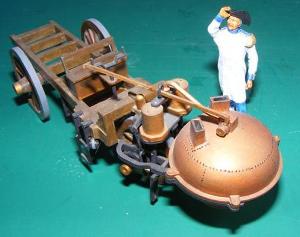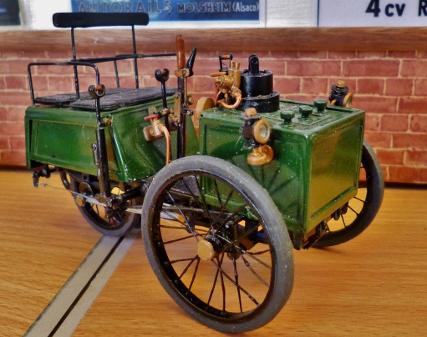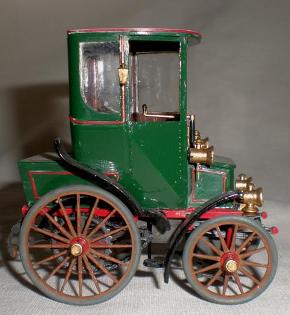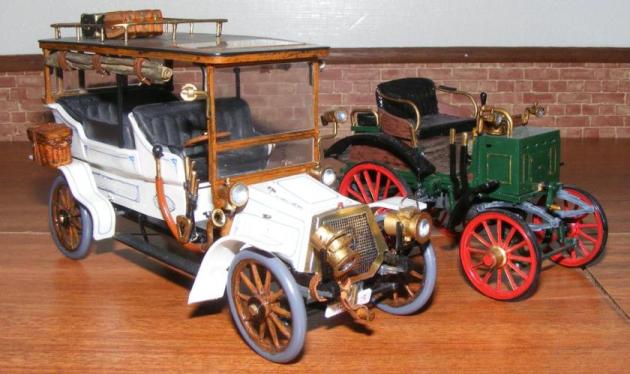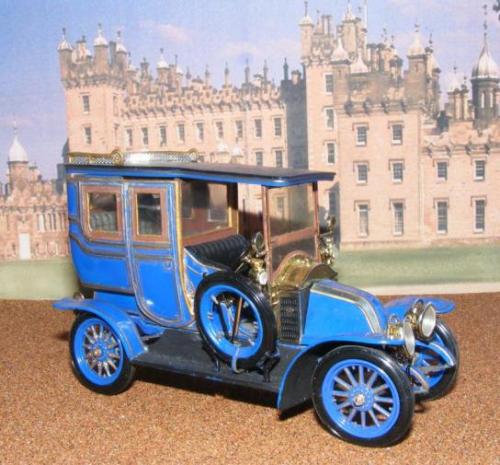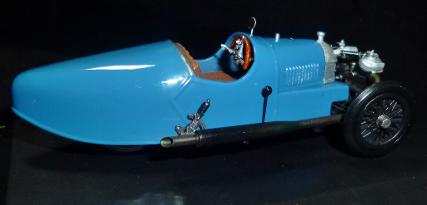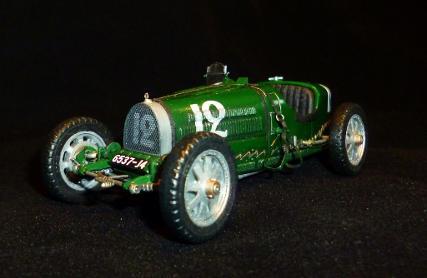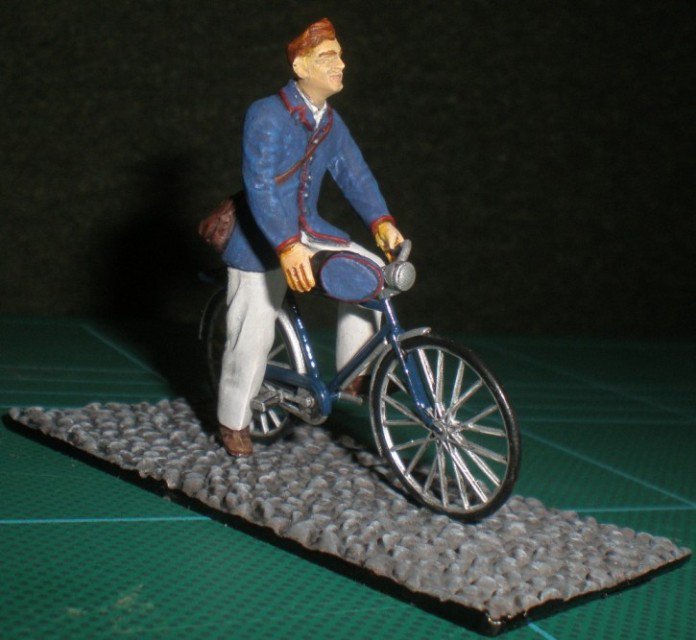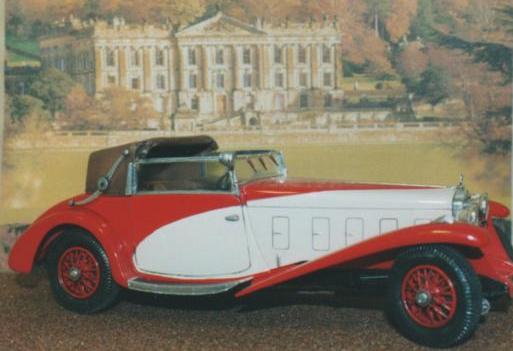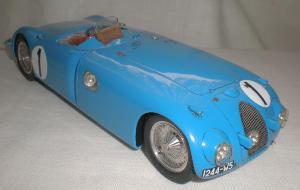
1886 de Dion, Bouton & Trepardoux steam Quadricycle.
1/24th scale scratch built model.
In 1882 a small Parisian engineering workshop run by Georges Bouton and Charles Trépardoux was visited by the Count de Dion who had seen their models and scientific toys, including a beautifully made small steam engine.
Count de Dion himself had an engineering interest and he was looking for someone to work with him in building a steam vehicle to vie with the new spirit driven automobiles. The design is four wheeled but with the two driven rear wheels so close together it has the appearance of a tricycle. The vehicle also has pneumatic tyres which is one of the earliest uses of them on a motor car.
A similar vehicle took part in the very first organised automobile competition in 1887, the 2km course ran from Neuilly Bridge to the Bois de Boulogne. Georges Bouton won the event on the de Dion, Bouton & Trépardoux machine.
by 1893 The Panhard system (as it was referred to despite being designed by Levassor) was now well established - Front wheel steering, front mounted engines, transmission (chain) to driven rear wheels and all the passengers facing forward - and remained the basic design layout for cars for decades.
9 years later production had passed 1000 mark and cars were being sold in London by the Hon. Charles Rolls, who raced Panhards at this time.
1895 P&L Paris-Bordeaux-Paris race car.
1/32nd scale Europe kit conversion
The Paris-Bordeaux-Paris Trial became the first real motor race, as all the 46 competitors started together, en mass. Émile Levassor (driving a two-cylinder, 1205 cc, 750-rpm, four-horsepower Daimler Phoenix engined car), started carefully, observing his opponents. Stopping regularly to check his car's components Levassor led for most of the race.
Arriving in Bordeaux several hours before anyone was expected Levassor found the driver who was to be his replacement was still asleep in a hotel, and no-one knew which one! Levassor accepted the situation calmly, woke the organisers to record his time, then, after taking a brief walk, eating some sandwiches (and having a drink of champagne), at 2:30 am he set off on the return leg to Paris.
After two days and nights behind the wheel Levassor drove triumphantly into Paris. His time for the 732 mile journey was 48hrs47min's, an average speed of just over 15mph. It was nearly six hours before the runner-up appeared.
1898 Panhard et Levassor racing car.
1/32nd scale scratch built model.
Car #1 is PL's 1898 winning car from the Paris-Amsterdam race.
Although the rear wheels are still larger than the front other developments are clearly taking shape.
The car is lower and has an inclined steering wheel rather than a tiller and the electric spark ignition boosted the straight four cylinder 8hp engine up to 18hp.
1899 Renault Type A.
1/24th scale scratch built model
Louis Renault, son of a button manufacturer, turned to cars and built a single cylinder De Dion engine powered prototype with shaft transmission as opposed to the more fashionable chain drive. Intended for his own pleasure it aroused much interest among his friends, who ordered replicas. The car has a unique feature for the period, it could be started from the drivers seat by the crank handle protruding from the dashboard, a feature popular with the lady drivers.
Renault set up Renault Freres in March 1899 with 40,000 francs capital put up by his brothers.
The car displayed at the Paris Automobile Salon in June and generated 60 orders. Renault then set up a factory and 179 cars were made in 1900, the first full year of production. This was the company’s first production car.
1902 Renault 'K' type light car class racer.
1/43rd scale kit
When the Renault brothers set up their company they immediately saw that racing brought car brands publicity and popularity. Starting out in the small car, or "voiturettes", categories they quickly made a name for themselves in the city-to-city races in the early years of the 29th century.
Renault moved up a category for the 1902 Paris-Vienna event. They entered 3 Type K “light cars” alongside 4 of their small cars. Having to cross the Alps through the Arlberg Pass, 1,500m above sea level, the going was always going to be tough.
The Type K was small and light and nobody gave them much of a chance against the large and powerful vehicles. The Type K’s light weight made it very competitive on the steep roads and Marcel Renault took advantage to cross the finish line first, having covered the 1,300 km at an incredible average speed of 62.5kph! His winning time being 15:47:43.
1904 10/12hp Darracq "Genevieve"
Scratch built model in 1/24th scale.
When it comes to complex layers of history that make a story hard to tell, then the history of Darracq is probably the example to prove it. Alexandre Darracq has the same mix of drive, ingenuity (both mechanical and financial) and awkwardness that seem to typify the many great designers and manufacturers in the history of motoring. Born in Bordeaux, France, on the 10th of November, 1855, Pierre-Alexandre Darracq was of Basque heritage. By the time he died in Monaco, 1931, Alexandre Darracq had proven himself a successful businessman having founded Gladiator bicycles (with all their own fame, records and race wins), designed an electric car, established his eponymous motor car company and manufactured his own design of cars in Suresnes, France and Coleman Street, London, Britain.
1906 Renault town car.
1/32nd scale Pyro kit.
Louis Renault built a single cylinder De Dion engine powered prototype with shaft transmission as opposed to the more fashionable chain drive.
Intended for his own pleasure it aroused much interest among his friends, who ordered replicas.
Renault Freres was set up in March 1899. The car when displayed at the Paris Automobile Salon in June brought in 60 orders. Renault then set up a factory and 179 cars were made in 1900, the first full year of production.
Drawing upon his aviation experience he set two precedents, using aircraft technology and one piece body/chassis construction, which were decades ahead of their time.
Unitary construction did become common practice in the 1950s but true monocoque designs really found their place in motor racing as late as 1962.
1930 Bugatti Type 35b.
1/24th scale Monogram kit
The Type 35 Bugatti made its debut in the 1924 French Grand Prix at Lyon and was Immediately recognised as an outstanding machine combining mechanical functionality and handsome looks. The final version of the Type 35 series was the Type 35B (sometimes titled 35TC) of 1927 which had a 130hp, 2,262cc, straight 8-cyl engine.
The engine was the heart and soul of the car featuring 5 main bearings for the crankshaft and roller bearings for the big ends which helped raise the safe engine rev’ limit by around 50% and thus increased power too. The cylinders were cast in pairs with an integral head housing 2 inlet and 1 exhaust valve. The valves being operated by a single overhead camshaft. and cross over finger rockers. A Roots-type Bugatti supercharger helped raise performance to a top speed of 125mph, the car making 0-60mph in six seconds.
1/24th scale Heller Kit.
Louis Delage gained his experience in a long period working for Peugeot. In 1905 he produced his first car with the assistance of Augustine Legros. In 1908, Delage won his first race, the Dieppe GP for voiturettes. For as long as his company was involved in racing it won remarkable victories, including the 1914 Indianapolis 500. It almost totally dominated the racing scene in its final GP season of 1927.
The D8 came out in 1929 with an 8-cylinder engine; depending on whether the version had one (D8), two (D8S and D8SS) or four carburettors (D8SS 100), it could develop from 80 to 100hp.
1934 Bugatti Type 59.
1/18th scale Bburago kit
Bugatti’s last serious Grand Prix car, powered by a 3,257 cc twin-cam straight 8 engine. The rear suspension consisted of inverted semi-elliptic leaf springs and the wheel rims had external spokes and aluminium inner discs. It won minor GP’s but was not truly successful.
It is a tribute to the innovative ideas and quality of build that the drawbacks Ettore Bugatti placed upon the cars by steadfastly sticking to two seat bodywork and cable operated brakes could be overcome.
Jean-Pierre Wimille drove no.10 in the 1934 Monaco GP.
1939 Citroen 15/6 'Traction Avant'.
1/24th scale Heller kit
The ‘Traction’ was introduced at the 1934 Motor Show in 3 forms, the ‘7’,’11’ & ‘22’. Andre Lefebvre was the man who organised the building of this revolutionary car in 13 months.
But Andre Citroens firm met financial difficulties in 1934 and the Michelin Co. took over the factory. Citroen then proceeded with a more powerful car and the 15 with 2867cc 6 cyl. in line engine appeared in 1938.
In 1948 the engine was designed to rotate ‘clockwise’. Why it had rotated anti-clockwise before that date has never been known!
1939 Type 57 ‘tank’ le Mans Winner.
1/24th scale, is from the Profil24 kit
Bugatti had success in racing at le Mans and after winning the 1937 race decided it wasn’t worth the effort and expense of doing it again. Why would you want to prove you can win it when you already have!
In 1939 Bugatti’s son convinced him that they should continue the le Mans programme but Ettore Bugatti put in a limit of his own. “As only one car can win, you can only build one car”.
One car was built, and it duly won!
1953 Pierre Barbot Citroen 2CV Special.
1/24th scale Heller kit conversion.
After the second world war Citroen revived it's small car programme with the 2CV. A cheap, economical, reliable, practical mode of transport was the aim; the idea of racing them was never entertained.
However, affordable reliable cars often turn out to be ideal for racing, like the Mini for instance. Pierre Barbot was a talented engineer and also a visionary when it came to his competition special. Take the 375cc 2CV and reduce the engine capacity to 348cc in order to compete in the under 350cc classes.
Between 1951 and 1953 Barbot built and refined his vehicle until it was ready to race. It won its class at the Bol d'Or and followed it up with nine international records for speed, time and distance later the same year. It also launched a very young Jean Vinatier on the road to endurance rally stardom.
1982 Renault RE30b.
1/20th scale Tamiya kit
Renault have a substantial history of innovation in motor sport, although most people don’t look back as far as the earliest motor races, so the Renault brothers many wins were long forgotten when Renault burst back onto the F1 GP scene in the mid 1970s. The establishment scoffed at the turbo engine just as they had laughed at the first shaft drive transmissions, these cynics were wrong in 1902 and they were wrong again in the “modern” era.
The Renault RE30 was designed by Michel Tétu and Gérard Larrousse for the 1981 season. It was made from Aluminium honeycomb structures but had the new, and increasingly common place, carbon fibre material woven into some parts of its construction.
In time the turbo Renault GP cars would win, and push F1 into a new "Turbo" era of engine design.
1991 Bugatti EB110.
1/24th scale Heller kit
The promising rebirth of the name in 1991 gave us the EB110. It was named to recognise Mr. Bugatti's 110th birthday by using his initials instead of a traditional ‘type’ number. The companies aims outstripped it’s resources and it nearly collapsed to leave us bereft again, but VW stepped in to rescue Bugatti and have produced some very modern super cars of outstanding quality to maintain the heritage of this most emotive brand name.
